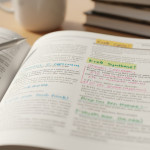Why Paired Passages Are Gone in the Digital SAT
If you took practice tests on paper and then opened the Bluebook app for the first time, one small but striking difference probably jumped out: those classic paired passages — two long texts followed by a dozen questions that ask you to compare, contrast, and synthesize — are mostly gone. This change isn’t random. It’s an intentional redesign tied to the move from paper to a fully digital, adaptive SAT. In this post we’ll explore why paired passages were removed, what replaced them, how that affects your test-taking strategy, and practical steps you can take to adjust your studying — including how Sparkl’s personalized tutoring can fit into a smart plan.
The short answer
College Board redesigned the reading experience to favor many shorter passages, usually with one focused question per passage instead of long, multi-question passages or paired passages. The goal was to make questions more direct, better suited to digital delivery, and more focused on the specific knowledge and skills that matter for college and career readiness.
Why the change makes sense
At first, removing paired passages can feel like losing a familiar study landmark. But when you step back and consider the nature of digital testing — screen size, timing, and adaptive delivery — the redesign becomes logical. Here are the main reasons behind the decision.
1. Digital formats favor shorter, targeted items
On a screen, long blocks of text are harder to manage than on paper. Shorter passages reduce cognitive load and help focus attention. When each item ties to a single, clearly defined skill, it’s easier to assess that skill precisely. Instead of a student getting stuck on a heavy comparative question and then underperforming on several subsequent items that depend on the same passage comprehension, each short item can independently measure a specific reading or writing ability.
2. Better alignment with adaptive testing
The digital SAT uses adaptive mechanics that select items based on performance. Paired passages create clusters of dependency: several questions rely on understanding the same long text(s). That complicates adaptive selection because the test engine would need to consider entire passage-question bundles rather than independent items. Shorter, stand-alone items let the adaptive algorithm more cleanly choose questions that match a student’s skill level without large, interdependent blocks of text interfering.
3. Faster, fairer sampling of skills
Think of the reading section as a skills sampling process. With many short texts, the test can sample a wider set of genres, tones, perspectives, and question types within the same time frame. This approach reduces the risk that a single long passage — perhaps on a topic a student finds unfamiliar — will disproportionately influence their entire section score. In short: more samples, less chance of bad luck.
4. Focused assessment of what matters
College Board has emphasized that the digital SAT is designed to measure the skills that predict college success. That’s easier to do with concise items aimed directly at the skill being measured — such as inference, evidence, or rhetoric — rather than long sequences of questions that can blend multiple skill sets across one passage.
What specifically changed in Reading & Writing?
The format shift replaces a few long passages and paired passages with a larger number of short passages or text excerpts. Each short passage is typically tied to one question, or a very small set of questions that are tightly focused. You’ll still see a range of passage types — literary excerpts, historical documents, science, and social sciences — but they will generally be shorter and more targeted.
How the experience feels different on test day
- Less time spent scrolling and flipping between long passages.
- Quicker context switches: one moment you might read a sentence-long excerpt about a scientific study, the next you’re reading a short 2–3 paragraph opinion passage.
- Questions are often more direct and specific, requiring a precise move (identify the author’s attitude, choose the best evidence, revise a sentence for clarity).
- Fewer compound questions that rely on comparing two passages. When contrasts are required, they’ll usually be compressed to one tightly framed question.
Does this make the Reading & Writing section easier or harder?
The answer is nuanced: easier in some ways, harder in others. The shift reduces the endurance challenge of reading long passages under time pressure, and it diminishes the risk of getting bogged down by one dense segment that ruins multiple questions. But it also raises the premium on rapid comprehension and precision. Since each short passage is tied to a single item, your margin for misreading is smaller — one missed inference equals one missed question. That makes fluency and quick, accurate reading more valuable than ever.
Real-world comparison
Imagine two chefs being tested. One must cook a whole banquet (like the old long passage set) while several judges critique each dish — the banquet chef could recover if a few dishes shine. The other must make many small, perfect tapas (like short passages), each judged individually: no single tiny mistake can be hidden by a spectacular follow-up. The digital SAT’s reading section is moving toward the tapas model.
How to adapt your study strategy
Shifting from a strategy built around paired passages to one designed for short, focused texts requires adjustments in technique, pacing, and practice materials. Here’s a study roadmap to help you master the new format.
1. Train for speed and precision
With short passages, you don’t need to memorize long paragraphs — you need fast, accurate extraction skills. Practice these drills:
- One-minute passage scan: read a 150–200 word passage and write the main idea in one sentence.
- Evidence matching: given a claim, find the sentence or phrase in the passage that best supports it (time limit: 45 seconds).
- Tone micro-practice: identify the author’s attitude or tone using only three words.
2. Build micro-annotation habits
On paper, students often underline and annotate. Digitally, annotation is different but still possible: mark keywords mentally or use the Bluebook tools during practice to highlight. Adopt a consistent micro-annotation system — for example, circle the topic sentence, star surprising facts, underline the main claim — then practice making those marks quickly so they become automatic.
3. Practice context switching
One of the subtle challenges of many short passages is the cognitive cost of switching contexts rapidly. Build stamina by mixing short passages from different genres in a single practice block: a paragraph of nineteenth-century prose, then a quick science blurb, then a historical letter. Time yourself so switching becomes second nature.
4. Keep your evidence game sharp
Even though paired passages are gone, evidence-based questions remain. Practice pinpointing the exact phrase that justifies an answer choice rather than relying on broad paraphrase. A good drill: for each answer you mark correct, write or say aloud the specific phrase from the passage that justifies it.
5. Use high-quality digital practice
Mock tests that mirror the digital experience are invaluable. Practice on the same platform mechanics — scrolling, highlighting, navigation — so the interface itself doesn’t distract you during the real test. If you’re working with a tutor or a program like Sparkl, ask them to simulate realistic Bluebook sessions so you get comfortable with the timing and layout.
Sample practice plan (4 weeks)
Here’s a compact plan that targets the skills required under the new format. Adjust the pace to match your baseline and goals.
| Week | Focus | Daily Activities (30–90 min) |
|---|---|---|
| 1 | Speed & micro-comprehension |
|
| 2 | Context switching & genre exposure |
|
| 3 | Precision under pressure |
|
| 4 | Polish & test strategy |
|
Common pitfalls and how to avoid them
The new format introduces a few traps students should watch out for. Recognizing these early saves time and points.
Pitfall: Rushing and misreading
When passages are short, students often assume they can skim. Skimming backfires when a single phrase is the key to the correct answer. Solution: practice micro-reading — slow down for the first 10–15 seconds to lock in the main claim, then move fast.
Pitfall: Overrelying on memory
Because you’ll jump between many brief passages, it’s tempting to rely on short-term recall of earlier paragraphs. Instead, treat each item as a fresh mini-task. Use quick highlights or mental anchors (topic sentence, data point, transition word) to reduce memory load.
Pitfall: Missing the nuance in ‘evidence’ questions
Evidence questions are now surgical: they often require identifying the exact line that supports an inference. Solution: read the question first when possible, then scan for supporting language. Practice pairing claim-and-evidence under timed conditions.
How tutors and personalized plans help
Changes like this are exactly the moment when targeted guidance pays off. A good tutor or personalized program can help you in three ways:
- Diagnostic clarity: identify which micro-skills (main idea, inference, evidence, tone) are costing you the most points.
- Tailored practice: give you bite-sized passages and drills with feedback targeted to your weak points.
- Test-simulation: recreate the exact digital interface, pacing, and navigation so your mental energy on test day is focused on content, not format.
If you’re exploring tutoring, Sparkl’s personalized tutoring model offers 1-on-1 guidance, tailored study plans, expert tutors, and AI-driven insights that adjust practice to where you actually need it — not just generic drills. That kind of tailored attention can accelerate the shift from paper-era strategies to digital-ready skills.
Practice resources and what to look for
When choosing practice materials, prioritize digital-first resources that replicate the shorter passage model. Avoid sets that only rehearse long, paired passages unless you’re also practicing the newer formats.
Checklist for quality practice material
- Short, focused passages with one-to-two questions each.
- Detailed explanations that point to explicit evidence in the text.
- Digital interface simulation (highlighting, scrolling, timing).
- Adaptive practice so question difficulty adjusts to your performance.
How to practice with friends or a tutor
Studying with others can be motivating, but the new format rewards individualized feedback. If you study with peers, try structured mini-sessions:
- Round-robin micro-quizzes: each person prepares 8 short passages and everyone times themselves.
- Evidence relay: one person states a claim; another must find the exact phrase that supports it within 30 seconds.
- Reflection share: after each set, spend five minutes explaining one mistake — teaching someone else crystallizes your own understanding.
With a tutor (or Sparkl’s 1-on-1 sessions), you can zero in on your specific pattern of errors, which shortens the path to higher accuracy under the new rules.
Sample mini-exercises (try these daily)
- 90-second main idea: read a 150-word passage and write the main idea in one sentence.
- Evidence snap: read a claim and underline the single line that supports it (40–60 seconds).
- Tone triad: pick three words that best describe the author’s stance; justify each word with a single phrase from the text (60 seconds).
Scoring implications and smart guessing
Because the digital SAT still reports section scores in familiar ranges, your strategy must balance speed and accuracy. Smart guessing remains important: eliminate wrong options quickly, and make an educated guess rather than leaving a question blank. The higher the precision of your first-pass reading, the fewer questions you’ll need to mark for review.
Final thoughts: agility beats endurance
Paired passages were a hallmark of the paper SAT era — an endurance test of attention and comparative reasoning. The digital SAT, by design, rewards agility: the ability to move quickly between contexts, extract precise meaning, and support answers with exact evidence. That shift reflects a broader change in how assessments measure readiness: more precise, more digital-native, and more adaptable to individual performance.
For students, the good news is that these are teachable skills. With consistent micro-practice, realistic digital simulations, and targeted feedback — whether from a thoughtful tutor or a structured program like Sparkl that blends expert tutors with AI-driven insights — you can convert the new format from an unknown into an advantage. Study smart, practice intentionally, and remember: the test changed, but the path to improvement remains the same — focused effort, guided feedback, and steady practice.
Good luck — and if you want help building a study plan tailored to the short-passage format, consider scheduling a diagnostic session. A few focused weeks of the right practice can make a big difference.
Quick checklist before test day
- Practice on a device similar to your test device; get comfortable with the Bluebook interface.
- Drill evidence and main-idea skills until they feel automatic.
- Simulate context switching with mixed-genre blocks.
- Use micro-annotation habits and keep them consistent.
- Get targeted feedback from a tutor or a personalized program to correct bad habits early.
Parting encouragement
Format changes can be unsettling, but they’re also opportunities. The Digital SAT rewards clarity, speed, and precision — skills that help not just on test day but in college reading, research, and professional life. With a plan that emphasizes short-passage mastery and evidence-based answering, you’ll be ready to turn this new format into your advantage.
Want help making a personalized plan that fits your schedule and learning style? A targeted 1-on-1 tutoring approach — the sort that combines expert tutors, adaptive practice, and AI-driven insights — can shorten your path to a higher score. When you pair deliberate practice with smart guidance, the test becomes a challenge you can manage rather than a surprise you have to survive.














No Comments
Leave a comment Cancel